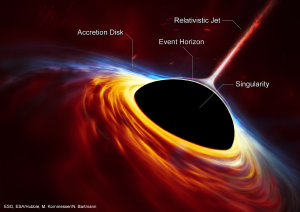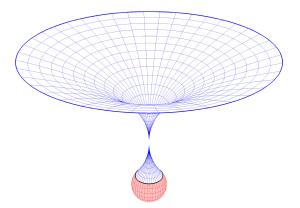Blog
Are We Living
in a Black Hole?
4 September 2015
 ESO, ESA/Hubble, M.Kornmesser/N.Bartmann; Labels: NASA/CXC
ESO, ESA/Hubble, M.Kornmesser/N.Bartmann; Labels: NASA/CXCHere’s an idea, what if the universe and everything we see around us is actually inside a black hole?
Whenever I’m asked this question, what folks typically have in mind is that the universe began as an infinitely dense point, just like the singularity of a black hole, and because of cosmic expansion there’s a limit to how far we can observe, so maybe that’s like the event horizon. While it’s an interesting idea, things aren’t quite so simple.
To begin with, the universe did not begin with an explosion from a single point. It was definitely very hot and dense in its early period, but it didn’t begin as a singularity. In fact there is debate whether black holes themselves have singularities. So while there are similarities between the two, we can’t simply equate them.
The limit of what we observe (the size of the observable universe) also doesn’t match up with the hypothetical event horizon of a “cosmic” black hole. For any mass you can calculate what is known as the Schwarzschild radius, which is the radius of a simple black hole of that mass. The mass of the observable universe is on the order of 1054 kg, which gives a Schwarzschild radius about 5 times larger than that of the observable universe.
So maybe we’re just in a really big black hole, and we just see a part of it. Not really. Just because you can calculate a Schwarzschild radius that doesn’t mean an object is a black hole. Even if the Schwarzschild radius encloses all of your mass, it still isn’t necessarily a black hole. On a basic level the density of the observable universe is pretty uniform. If you don’t worry about cosmic expansion, then the radius of the observable universe increases at the speed of light with age, so the total mass of the observable increases with time. This is true in an expanding universe as well, but that’s a different story. The thing is, the Schwarzschild radius increases linearly with mass, but the enclosed mass of the observable universe increases with the radius cubed. As the observable universe increases over time, then the Schwarzschild radius eventually grows faster than the radius of the observable universe.
 Alan Guth
Alan GuthFor a true black hole you can’t just calculate its size. You have to look at the overall structure. Our universe isn’t collapsing in on itself, it’s expanding at an ever increasing rate. So it doesn’t have the necessary structure to be the interior of a black hole. But there are some models that do propose that our universe was formed by the black hole of another universe. These models are very speculative, but generally propose that the super-dense interior of a black hole could create a “baby universe” that expands to become its own universe. Technically you could say this new universe is “in” the black hole that spawned it, but because of the bendable nature of space and time that’s not particularly meaningful. The new universe would in no way be limited by the size of the black hole, and would exist on its own once it formed.
So it’s an interesting idea to speculate about, but there is no evidence to support the idea that our universe is in a black hole.